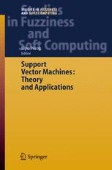Search
Search Results
-
Iterative Single Data Algorithm for Training Kernel Machines from Huge Data Sets: Theory and Performance
The chapter introduces the latest developments and results of Iterative Single Data Algorithm (ISDA) for solving large-scale support vector machines...
-
Application of Support Vector Machines in Inverse Problems in Ocean Color Remote Sensing
Neural networks are widely used as transfer functions in inverse problems in remote sensing. However, this method still suffers from some problems...
-
Tachycardia Discrimination in Implantable Cardioverter Defibrillators Using Support Vector Machines and Bootstrap Resampling
Accurate automatic discrimination between supraventricular (SV) and ventricular (V) tachycardia (T) in implantable cardioverter defibrillators (ICD)...
-
INTRODUCTION
Over the last decade, a series of publications has brought and established new research areas related to music, and intensified the research verging...
-
Kernel Discriminant Learning with Application to Face Recognition
When applied to high-dimensional pattern classification tasks such as face recognition, traditional kernel discriminant analysis methods often suffer...
-
Multiple Model Estimation for Nonlinear Classification
This chapter describes a new method for nonlinear classification using a collection of several simple (linear) classifiers. The approach is based on...
-
Active Support Vector Learning with Statistical Queries
The article describes an active learning strategy to solve the large quadratic programming (QP) problem of support vector machine (SVM) design in...
-
Introduction
Genetic algorithms (GAs) are powerful search techniques based on principles of evolution. They are now widely applied to solve problems in many...
-
Linkage Learning Genetic Algorithm
In order to handle linkage evolution and to tackle the ordering problem, Harik [47] took Holland’s call [53] for the evolution of tight linkage quite...
-
Preliminaries: Assumptions and the Test Problem
After introducing the background and motivation of the linkage learning genetic algorithm, we will start to improve and understand the linkage...
-
A New Theoretical Framework for K-Means-Type Clustering
One of the fundamental clustering problems is to assign n points into k clusters based on the minimal sum-of-squares(MSSC), which is known to be...
-
Fast Color Texture-Based Object Detection in Images: Application to License Plate Localization
The current chapter presents a color texture-based method for object detection in images. A support vector machine (SVM) is used to classify each...
-
Support Vector Machines – An Introduction
This is a book about learning from empirical data (i.e., examples, samples, measurements, records, patterns or observations) by applying support...
-
Improving the Performance of the Support Vector Machine: Two Geometrical Scaling Methods
In this chapter, we discuss two possible ways of improving the performance of the SVM, using geometric methods. The first adapts the kernel by...
-
The Mathematics of Learning: Dealing with Data *
Learning is key to develo** systems tailored to a broad range of data analysis and information extraction tasks. We outline the mathematical...
-
Web Page Classification*
This chapter describes systems that automatically classify web pages into meaningful categories. It first defines two types of web page...
-
Content Based Image Compression in Biomedical High-Throughput Screening Using Artificial Neural Networks
Biomedical High-Throughput Screening (HTS) requires specific properties of image compression. Particularly especially when archiving a huge number of...
-
Lattices of Fuzzy Subgroups
Many results concerning relationships between classes of crisp subsets can be carried over to similar relationships between classes of fuzzy subsets....
-
Discriminative Clustering of Yeast Stress Response
When a yeast cell is challenged by a rapid change in the conditions, be it temperature, osmolarity, pH, nutrient or other, it starts a genome stress...
-
Cluster Identification Using Maximum Configuration Entropy
Clustering is an important task in data mining and machine learning. In this paper, a normalized graph sampling algorithm for clustering that...
